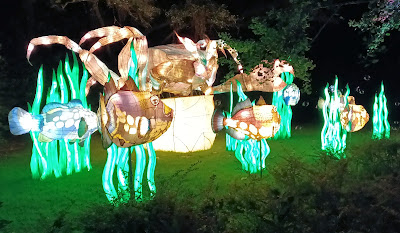Thursday I drove two hours to Bellingrath Gardens near Mobile, AL, and wow, was it worth it! I don't remember ever going there before, and the gardens were really a spectacular show. Throughout the grounds were special large-scale representations of flowers, dragons, and dolphins, which were all part of the Chinese Lantern Show now going on through June 15th.
Here are some photographs of the gardens during the day, as well as the lighted sculptures and special attractions better viewed after twilight. Some walkways reminded me of the movie "Avatar."
Click on the images to make them larger.
The Entrance to the Chinese Lantern Display
Turtles Day/Night
Shark Day/Night
Old Tree Growth in the Gardens
Dolphins
Mighty big crawfish
The Dragon Fish Day/Night
The Chinese Lantern Walkway Day/Night
The Slice Walkway Day/Night
The Chinese Dragon Day/Night
Alligator Day/Night
Tree sparkles at night
Pandas and Bamboo
A variety of creature lantern sculptures
Wings glowing
Play area for the kids (and adults)
Butterfly Lanterns
Venus Fly Traps
The Humming Bird Bench
An octopus and wasp
Trees that changed colors
Links of Interest
































































